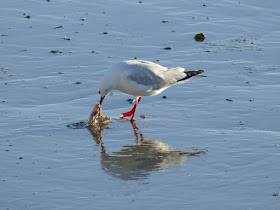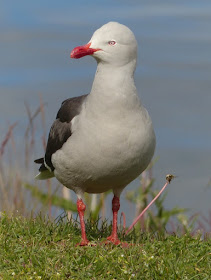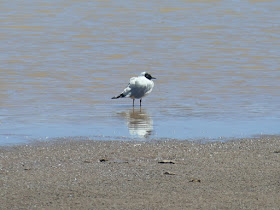'Gull' is a strange word, one of those back-formed in English through both misunderstanding and attempted Anglicisation of a foreign word. (Think of Spanish naranja, heard by English ears as 'an aranja', which became 'an orange'.) In the case of 'gull', it is not at all clear why the word even arrived in western England, from Welsh or Cornish Gaelic, in the 15th century. English is always borrowing words from other languages, and invaders (notably the Norman French) imposed new words on the populace, but Gaelic was certainly not a conquering language, and there is no obvious reason why the doubtless conservative folk of the west felt a need to replace the old cob and mew with another word. The fact stands however that they did. Gullen in Cornish and gwylan in Welsh were words for gull - both meant 'wailing'. However, they were interpreted as plural - like children or oxen - and gull was back-formed as the singular.
Gulls are everywhere, breeding on every continent including Antarctica. They are fairly uniform in appearance - we have no difficulty in recognising a gull, even one we've not previously seen. Indeed for a long time nearly all gulls were placed in the genus Larus, though DNA work has shown this to be too simplistic, and around 10 genera are now recognised. Overall they tend to be black, grey or white (often white head and darker back mantle) with coloured long legs and heavy bills. There are of course exceptions, and we'll come to some of those. Here are a couple of examples, modelling typical 'large gull' and 'small gull' outfits.
As I mentioned above, these patterns are by no means universal however. The Arctic-dwelling Ivory Gull Pagophila eburnea, is pure white. On the other hand the Galápagos endemic Lava Gull Leucophaeus fuliginosus is entirely grey-brown.
 |
| Lava Gull at sea, Galápagos. This is the world's scarcest gull, with population estimates of less than 250 birds. |
Some, in different genera, have dark heads or caps - these species often lose these dark caps when not breeding.
 |
| Brown-hooded Gulls Chroicocephalus maculipennis, Isla de Chiloé, Chile. This elegant little gull is found in much of southern South America. |
Wings are long and relatively slender, for soaring above the ocean, and sometimes hovering, albeit somewhat clumsily.
 |
| Band-tailed (Belcher's) Gull Larus belcheri, Pisagua, northern Chile. |
 |
| Brown-hooded Gull, Isla de Chiloé, Chile. |
Gulls have independently evolved the response to needing to drink salt water that many other seabirds have also done; glands above the eyes, which filter the blood flowing through them. The resultant salt solution runs in ducts down to the nasal passages, and drips off the end of the bill. (They have this in common with groups as disparate as penguins, petrels, pelicans, cormorants, frigate-birds and sea-ducks, among others.)
Like many different groups of swimming birds too, they have developed webbed feet, by bringing three toes to the front of the foot, and joining them with flexible skin.
This penchant for roosting in flocks is another characteristic; they may gather on the beach or inland.
 |
| A very small part of a huge flock of Pacific Gulls roosting in a paddock near the Tamar River, northern Tasmania. |
Among the adult Pacific Gulls above are scattered dark brown immatures. This change from dark or mottled plumage to adult garb over a couple of years for smaller species, or double that for larger ones, is typical of most gulls.
 |
| Second year immature Pacific Gull, Esperance, Western Australia. |
 |
| Immature Silver Gull, Nowra, New South Wales. The plumage is 'clean' and nearly adult, but the eye, bill and legs are still dark. |
 |
| Dolphin Gulls, adults and immatures (dark heads) Ushuaia, Argentina. |
 |
| Franklin's Gull immature, Española, Galápagos. In this case the adult (below) does have a black head and young birds don't! |
 |
| Juvenile Swallow-tailed Gull with parent, Genovesa, Galápagos. |
A strict hierarchy is maintained in the
flocks, especially with regard to food access, and aggression, both
threatened and actual, is common.
 |
| Dolphin Gull aggression (adult bullying immature, as is usual), Ushuaia. |
Breeding may take place in colonies or, more rarely, individually. Nests are often just a lined scrape on the ground, but there are variations on this theme.
 |
| Kelp Gull Larus dominicanus colony (with Magellanic Penguins), Isla Magdalena, Strait of Magellan, Chilean Patagonia. |
 |
| Kelp gull on nest, a ground scrape lined with grass and feathers, Isla Magdalena. |
 |
| Brown-hooded Gulls over breeding colony, Laguna Coluco, Isla de Chiloé, Chile. |
 |
| Brown-hooded Gull on floating nest, Laguna Coluco. |
 |
| Swallow-tailed Gull chick, Genovesa, Galápagos, above and below. Gull chicks hatch with eyes open and with down feathers; they can move around but stay in or near the nest to be fed. |
Mating tends to be for life, and pair bonds are maintained by displays and mutual grooming.
 |
| Swallow-tailed Gull pair allo-preening, South Plaza, Galápagos. |
Gulls are widely seen as scavengers - as indeed they are - but they are also quite capable of catching live food (eg the Swallow-tailed Gulls discussed earlier).
 |
| Brown-hooded Gulls scavenging spilt fish-meal, Puerto Montt, Chile. |
 |
| Pacific Gull eating dead fish, Esperance, Western Australia. |
 |
| Silver Gull with discarded fish-head, Cairns, tropical Queensland. |
 |
| Kelp Gulls (and Black-browed Albatross) fishing, Strait of Magellan. |
 |
| Immature Dolphin Gull with shellfish, Ushuaia, Argentina. I have seen Kelp Gulls in Chile carry mussels into the air and repeatedly drop them on the rocks to smash them open. |
Sometimes I think that familiarity, and the ability of some species to make a living on our scraps and garbage, leads to some contempt, or at least a lack of respect, for gulls. Like any animal though they are worthy of our attention - and there are some pretty handsome characters in their ranks!
BACK ON THURSDAY








It is possibly worthy of comment that in Northern North America Gulls become a main feature of interest for birders in Winter. This is primarily due to their ability, as you note above, to find food in landfills. So going to the sewage ponds for waterbirds in Summer is replaced by going to the tip for gulls in Winter.
ReplyDeleteIn Churchill, Manitoba - on the shores of Hudson's Bay - relatively rare gulls can often be found at the tip. So can Polar Bears which makes it one of the more dangerous birding spots.
The really expert/obsessive gull-watchers in the US and Canada don't just tick off species but record the many plumages (I think up to 7) within a species!